Impact of Job Stress on Amazon: A BUS101 Report, Semester 2, 2019
VerifiedAdded on 2022/10/17
|12
|2947
|11
Report
AI Summary
This BUS101 report examines the pervasive issue of job stress within Amazon, analyzing its causes, impacts, and potential solutions. The report defines job stress as the inability of employees to cope with job pressures, and it explores various factors contributing to this, including long working hours, tight deadlines, poor management practices, and lack of support. The study, based on qualitative data from 20 employees, reveals that a significant majority are suffering from job stress, leading to symptoms like fatigue, insomnia, and low performance. The research identifies key stressors such as poor management and lack of opportunities. The report concludes with recommendations for Amazon to provide a more conducive working environment to alleviate stress and improve employee retention and productivity, suggesting changes in management practices and addressing workload concerns.
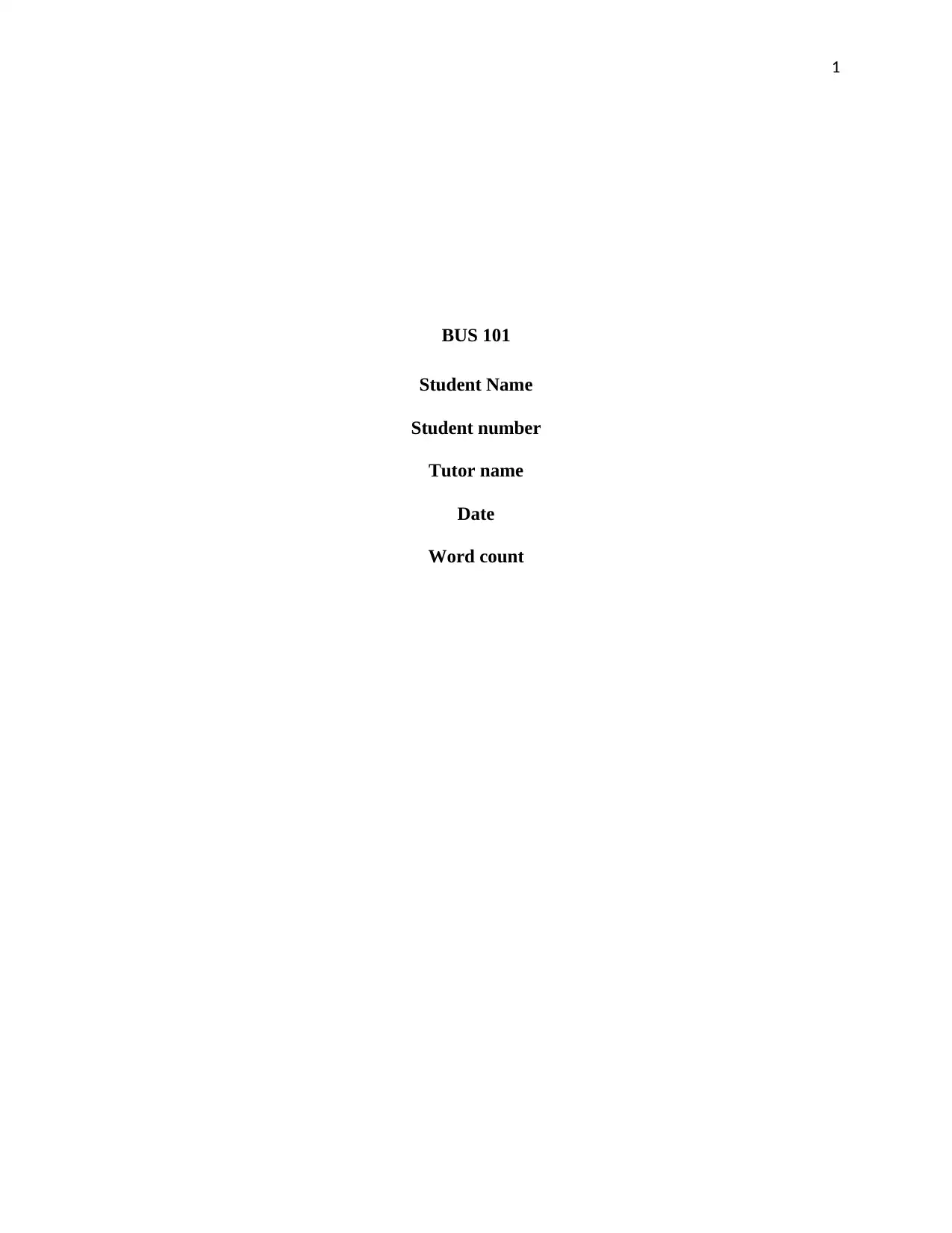
1
BUS 101
Student Name
Student number
Tutor name
Date
Word count
BUS 101
Student Name
Student number
Tutor name
Date
Word count
Paraphrase This Document
Need a fresh take? Get an instant paraphrase of this document with our AI Paraphraser
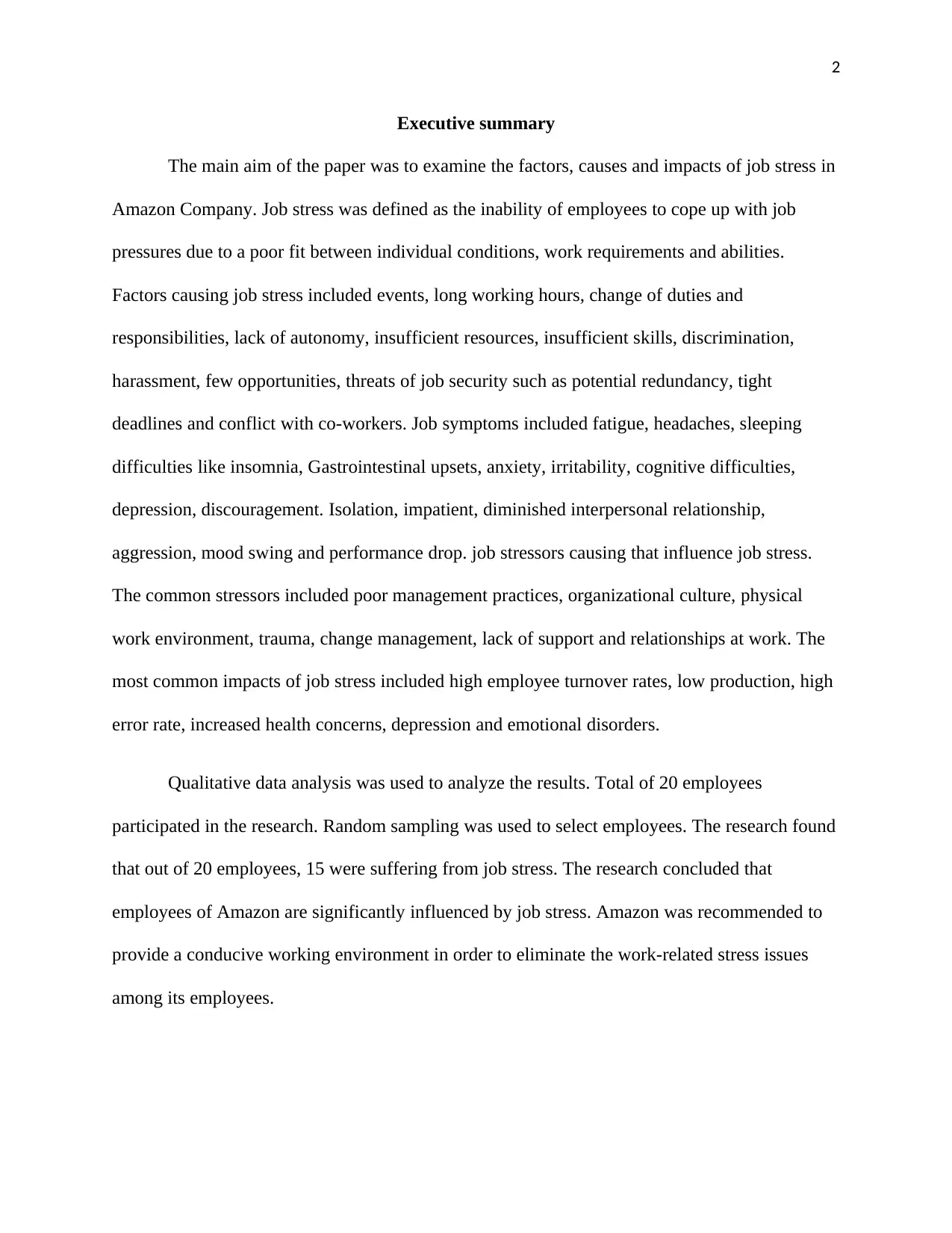
2
Executive summary
The main aim of the paper was to examine the factors, causes and impacts of job stress in
Amazon Company. Job stress was defined as the inability of employees to cope up with job
pressures due to a poor fit between individual conditions, work requirements and abilities.
Factors causing job stress included events, long working hours, change of duties and
responsibilities, lack of autonomy, insufficient resources, insufficient skills, discrimination,
harassment, few opportunities, threats of job security such as potential redundancy, tight
deadlines and conflict with co-workers. Job symptoms included fatigue, headaches, sleeping
difficulties like insomnia, Gastrointestinal upsets, anxiety, irritability, cognitive difficulties,
depression, discouragement. Isolation, impatient, diminished interpersonal relationship,
aggression, mood swing and performance drop. job stressors causing that influence job stress.
The common stressors included poor management practices, organizational culture, physical
work environment, trauma, change management, lack of support and relationships at work. The
most common impacts of job stress included high employee turnover rates, low production, high
error rate, increased health concerns, depression and emotional disorders.
Qualitative data analysis was used to analyze the results. Total of 20 employees
participated in the research. Random sampling was used to select employees. The research found
that out of 20 employees, 15 were suffering from job stress. The research concluded that
employees of Amazon are significantly influenced by job stress. Amazon was recommended to
provide a conducive working environment in order to eliminate the work-related stress issues
among its employees.
Executive summary
The main aim of the paper was to examine the factors, causes and impacts of job stress in
Amazon Company. Job stress was defined as the inability of employees to cope up with job
pressures due to a poor fit between individual conditions, work requirements and abilities.
Factors causing job stress included events, long working hours, change of duties and
responsibilities, lack of autonomy, insufficient resources, insufficient skills, discrimination,
harassment, few opportunities, threats of job security such as potential redundancy, tight
deadlines and conflict with co-workers. Job symptoms included fatigue, headaches, sleeping
difficulties like insomnia, Gastrointestinal upsets, anxiety, irritability, cognitive difficulties,
depression, discouragement. Isolation, impatient, diminished interpersonal relationship,
aggression, mood swing and performance drop. job stressors causing that influence job stress.
The common stressors included poor management practices, organizational culture, physical
work environment, trauma, change management, lack of support and relationships at work. The
most common impacts of job stress included high employee turnover rates, low production, high
error rate, increased health concerns, depression and emotional disorders.
Qualitative data analysis was used to analyze the results. Total of 20 employees
participated in the research. Random sampling was used to select employees. The research found
that out of 20 employees, 15 were suffering from job stress. The research concluded that
employees of Amazon are significantly influenced by job stress. Amazon was recommended to
provide a conducive working environment in order to eliminate the work-related stress issues
among its employees.
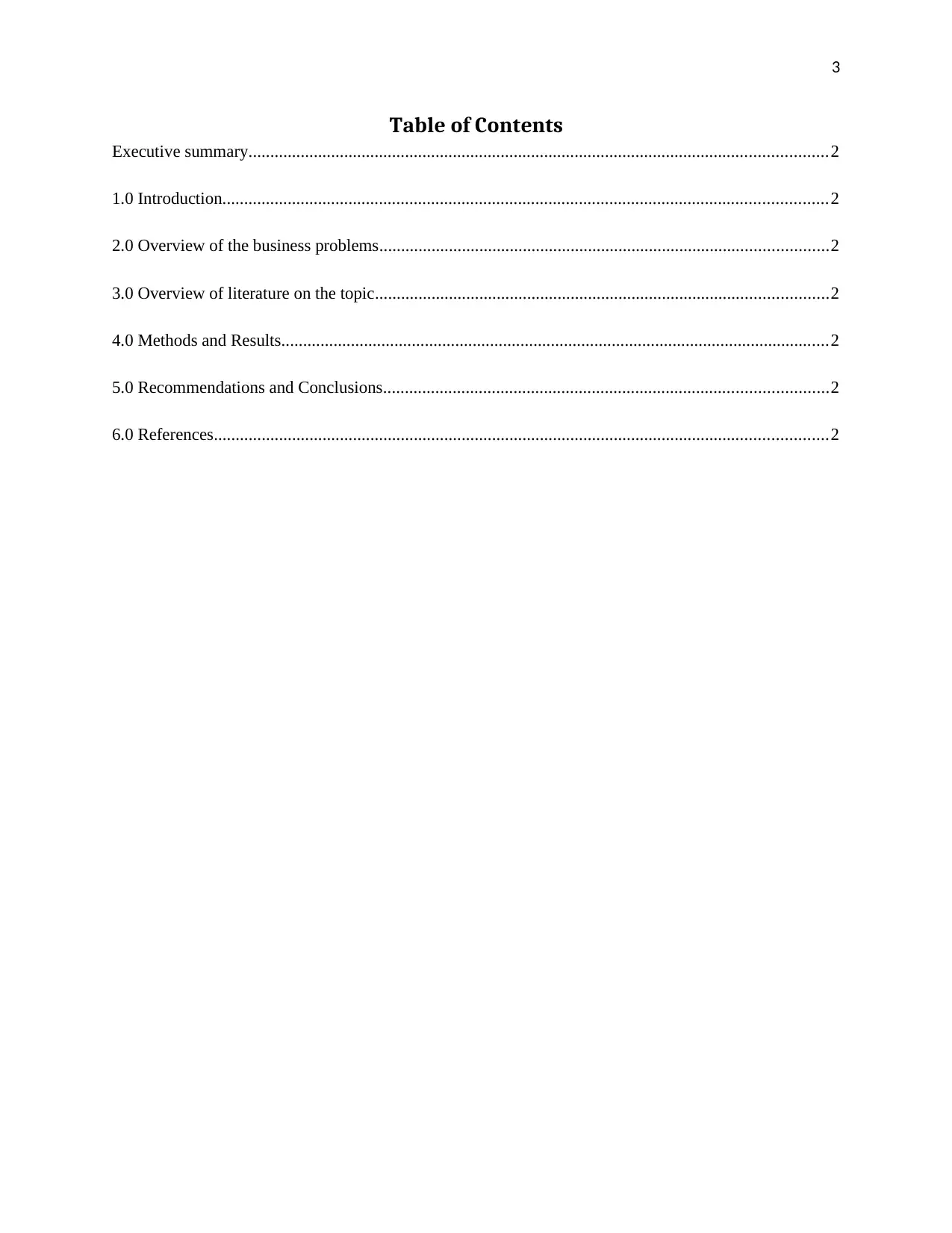
3
Table of Contents
Executive summary.....................................................................................................................................2
1.0 Introduction...........................................................................................................................................2
2.0 Overview of the business problems.......................................................................................................2
3.0 Overview of literature on the topic........................................................................................................2
4.0 Methods and Results..............................................................................................................................2
5.0 Recommendations and Conclusions......................................................................................................2
6.0 References.............................................................................................................................................2
Table of Contents
Executive summary.....................................................................................................................................2
1.0 Introduction...........................................................................................................................................2
2.0 Overview of the business problems.......................................................................................................2
3.0 Overview of literature on the topic........................................................................................................2
4.0 Methods and Results..............................................................................................................................2
5.0 Recommendations and Conclusions......................................................................................................2
6.0 References.............................................................................................................................................2
⊘ This is a preview!⊘
Do you want full access?
Subscribe today to unlock all pages.

Trusted by 1+ million students worldwide
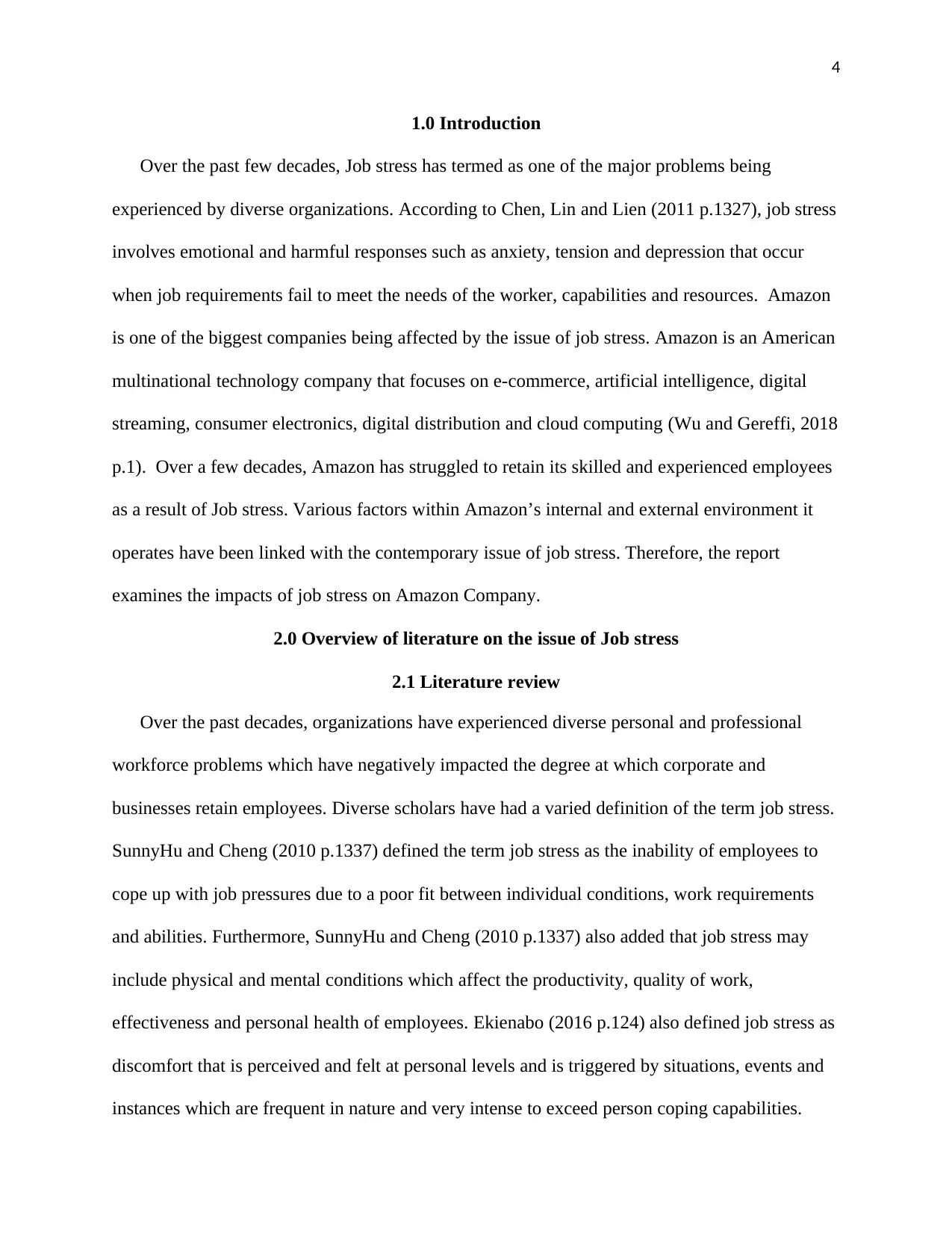
4
1.0 Introduction
Over the past few decades, Job stress has termed as one of the major problems being
experienced by diverse organizations. According to Chen, Lin and Lien (2011 p.1327), job stress
involves emotional and harmful responses such as anxiety, tension and depression that occur
when job requirements fail to meet the needs of the worker, capabilities and resources. Amazon
is one of the biggest companies being affected by the issue of job stress. Amazon is an American
multinational technology company that focuses on e-commerce, artificial intelligence, digital
streaming, consumer electronics, digital distribution and cloud computing (Wu and Gereffi, 2018
p.1). Over a few decades, Amazon has struggled to retain its skilled and experienced employees
as a result of Job stress. Various factors within Amazon’s internal and external environment it
operates have been linked with the contemporary issue of job stress. Therefore, the report
examines the impacts of job stress on Amazon Company.
2.0 Overview of literature on the issue of Job stress
2.1 Literature review
Over the past decades, organizations have experienced diverse personal and professional
workforce problems which have negatively impacted the degree at which corporate and
businesses retain employees. Diverse scholars have had a varied definition of the term job stress.
SunnyHu and Cheng (2010 p.1337) defined the term job stress as the inability of employees to
cope up with job pressures due to a poor fit between individual conditions, work requirements
and abilities. Furthermore, SunnyHu and Cheng (2010 p.1337) also added that job stress may
include physical and mental conditions which affect the productivity, quality of work,
effectiveness and personal health of employees. Ekienabo (2016 p.124) also defined job stress as
discomfort that is perceived and felt at personal levels and is triggered by situations, events and
instances which are frequent in nature and very intense to exceed person coping capabilities.
1.0 Introduction
Over the past few decades, Job stress has termed as one of the major problems being
experienced by diverse organizations. According to Chen, Lin and Lien (2011 p.1327), job stress
involves emotional and harmful responses such as anxiety, tension and depression that occur
when job requirements fail to meet the needs of the worker, capabilities and resources. Amazon
is one of the biggest companies being affected by the issue of job stress. Amazon is an American
multinational technology company that focuses on e-commerce, artificial intelligence, digital
streaming, consumer electronics, digital distribution and cloud computing (Wu and Gereffi, 2018
p.1). Over a few decades, Amazon has struggled to retain its skilled and experienced employees
as a result of Job stress. Various factors within Amazon’s internal and external environment it
operates have been linked with the contemporary issue of job stress. Therefore, the report
examines the impacts of job stress on Amazon Company.
2.0 Overview of literature on the issue of Job stress
2.1 Literature review
Over the past decades, organizations have experienced diverse personal and professional
workforce problems which have negatively impacted the degree at which corporate and
businesses retain employees. Diverse scholars have had a varied definition of the term job stress.
SunnyHu and Cheng (2010 p.1337) defined the term job stress as the inability of employees to
cope up with job pressures due to a poor fit between individual conditions, work requirements
and abilities. Furthermore, SunnyHu and Cheng (2010 p.1337) also added that job stress may
include physical and mental conditions which affect the productivity, quality of work,
effectiveness and personal health of employees. Ekienabo (2016 p.124) also defined job stress as
discomfort that is perceived and felt at personal levels and is triggered by situations, events and
instances which are frequent in nature and very intense to exceed person coping capabilities.
Paraphrase This Document
Need a fresh take? Get an instant paraphrase of this document with our AI Paraphraser
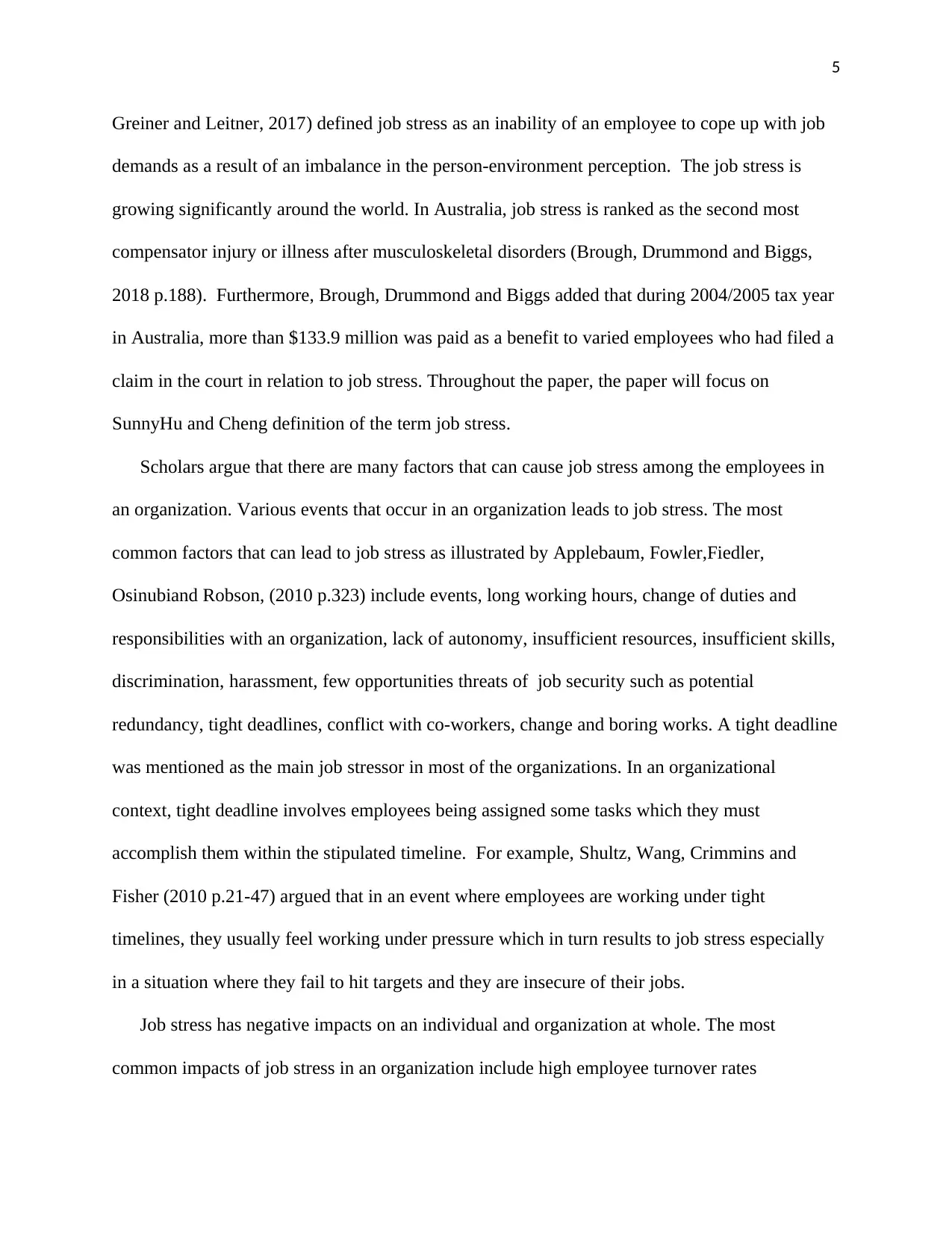
5
Greiner and Leitner, 2017) defined job stress as an inability of an employee to cope up with job
demands as a result of an imbalance in the person-environment perception. The job stress is
growing significantly around the world. In Australia, job stress is ranked as the second most
compensator injury or illness after musculoskeletal disorders (Brough, Drummond and Biggs,
2018 p.188). Furthermore, Brough, Drummond and Biggs added that during 2004/2005 tax year
in Australia, more than $133.9 million was paid as a benefit to varied employees who had filed a
claim in the court in relation to job stress. Throughout the paper, the paper will focus on
SunnyHu and Cheng definition of the term job stress.
Scholars argue that there are many factors that can cause job stress among the employees in
an organization. Various events that occur in an organization leads to job stress. The most
common factors that can lead to job stress as illustrated by Applebaum, Fowler,Fiedler,
Osinubiand Robson, (2010 p.323) include events, long working hours, change of duties and
responsibilities with an organization, lack of autonomy, insufficient resources, insufficient skills,
discrimination, harassment, few opportunities threats of job security such as potential
redundancy, tight deadlines, conflict with co-workers, change and boring works. A tight deadline
was mentioned as the main job stressor in most of the organizations. In an organizational
context, tight deadline involves employees being assigned some tasks which they must
accomplish them within the stipulated timeline. For example, Shultz, Wang, Crimmins and
Fisher (2010 p.21-47) argued that in an event where employees are working under tight
timelines, they usually feel working under pressure which in turn results to job stress especially
in a situation where they fail to hit targets and they are insecure of their jobs.
Job stress has negative impacts on an individual and organization at whole. The most
common impacts of job stress in an organization include high employee turnover rates
Greiner and Leitner, 2017) defined job stress as an inability of an employee to cope up with job
demands as a result of an imbalance in the person-environment perception. The job stress is
growing significantly around the world. In Australia, job stress is ranked as the second most
compensator injury or illness after musculoskeletal disorders (Brough, Drummond and Biggs,
2018 p.188). Furthermore, Brough, Drummond and Biggs added that during 2004/2005 tax year
in Australia, more than $133.9 million was paid as a benefit to varied employees who had filed a
claim in the court in relation to job stress. Throughout the paper, the paper will focus on
SunnyHu and Cheng definition of the term job stress.
Scholars argue that there are many factors that can cause job stress among the employees in
an organization. Various events that occur in an organization leads to job stress. The most
common factors that can lead to job stress as illustrated by Applebaum, Fowler,Fiedler,
Osinubiand Robson, (2010 p.323) include events, long working hours, change of duties and
responsibilities with an organization, lack of autonomy, insufficient resources, insufficient skills,
discrimination, harassment, few opportunities threats of job security such as potential
redundancy, tight deadlines, conflict with co-workers, change and boring works. A tight deadline
was mentioned as the main job stressor in most of the organizations. In an organizational
context, tight deadline involves employees being assigned some tasks which they must
accomplish them within the stipulated timeline. For example, Shultz, Wang, Crimmins and
Fisher (2010 p.21-47) argued that in an event where employees are working under tight
timelines, they usually feel working under pressure which in turn results to job stress especially
in a situation where they fail to hit targets and they are insecure of their jobs.
Job stress has negative impacts on an individual and organization at whole. The most
common impacts of job stress in an organization include high employee turnover rates
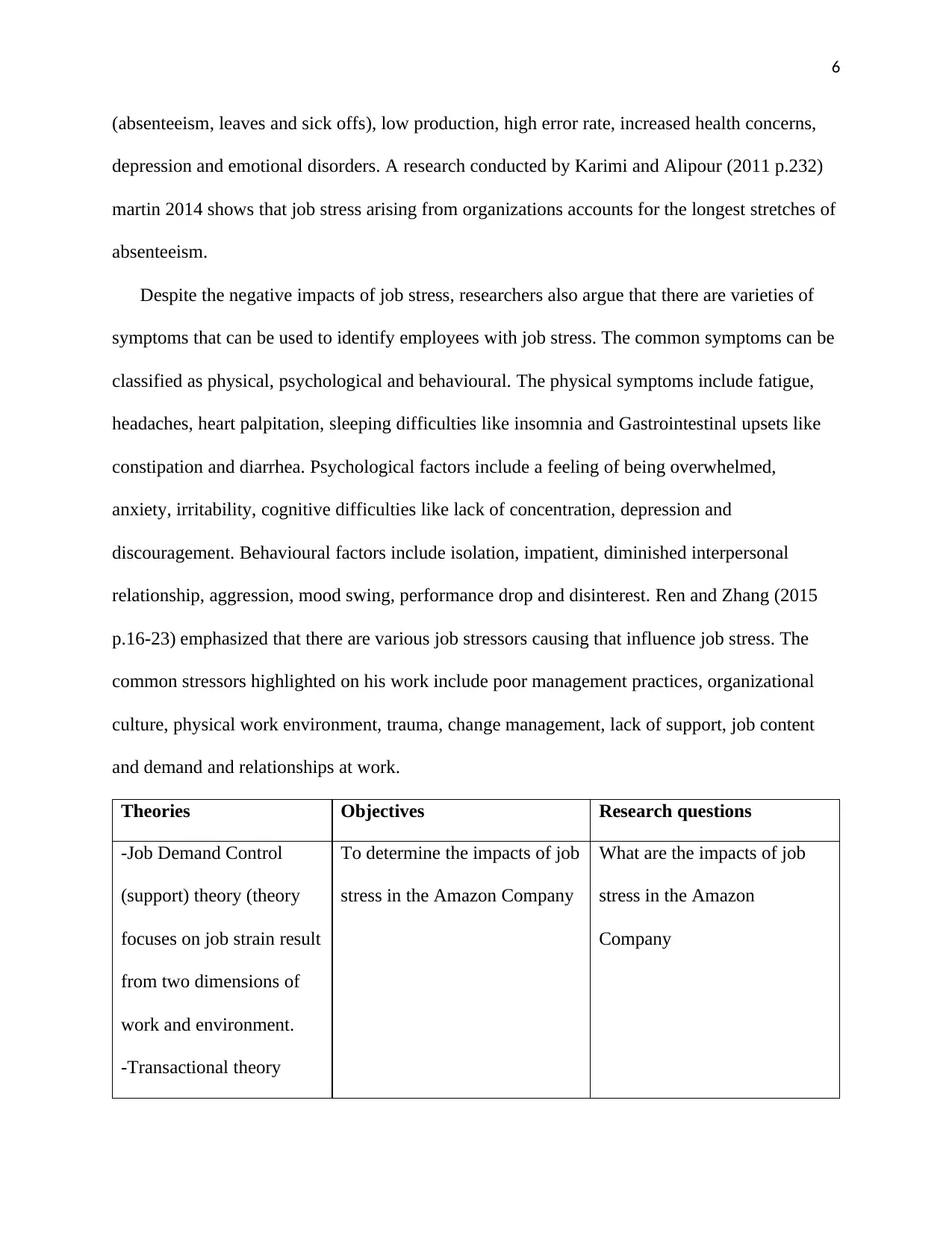
6
(absenteeism, leaves and sick offs), low production, high error rate, increased health concerns,
depression and emotional disorders. A research conducted by Karimi and Alipour (2011 p.232)
martin 2014 shows that job stress arising from organizations accounts for the longest stretches of
absenteeism.
Despite the negative impacts of job stress, researchers also argue that there are varieties of
symptoms that can be used to identify employees with job stress. The common symptoms can be
classified as physical, psychological and behavioural. The physical symptoms include fatigue,
headaches, heart palpitation, sleeping difficulties like insomnia and Gastrointestinal upsets like
constipation and diarrhea. Psychological factors include a feeling of being overwhelmed,
anxiety, irritability, cognitive difficulties like lack of concentration, depression and
discouragement. Behavioural factors include isolation, impatient, diminished interpersonal
relationship, aggression, mood swing, performance drop and disinterest. Ren and Zhang (2015
p.16-23) emphasized that there are various job stressors causing that influence job stress. The
common stressors highlighted on his work include poor management practices, organizational
culture, physical work environment, trauma, change management, lack of support, job content
and demand and relationships at work.
Theories Objectives Research questions
-Job Demand Control
(support) theory (theory
focuses on job strain result
from two dimensions of
work and environment.
-Transactional theory
To determine the impacts of job
stress in the Amazon Company
What are the impacts of job
stress in the Amazon
Company
(absenteeism, leaves and sick offs), low production, high error rate, increased health concerns,
depression and emotional disorders. A research conducted by Karimi and Alipour (2011 p.232)
martin 2014 shows that job stress arising from organizations accounts for the longest stretches of
absenteeism.
Despite the negative impacts of job stress, researchers also argue that there are varieties of
symptoms that can be used to identify employees with job stress. The common symptoms can be
classified as physical, psychological and behavioural. The physical symptoms include fatigue,
headaches, heart palpitation, sleeping difficulties like insomnia and Gastrointestinal upsets like
constipation and diarrhea. Psychological factors include a feeling of being overwhelmed,
anxiety, irritability, cognitive difficulties like lack of concentration, depression and
discouragement. Behavioural factors include isolation, impatient, diminished interpersonal
relationship, aggression, mood swing, performance drop and disinterest. Ren and Zhang (2015
p.16-23) emphasized that there are various job stressors causing that influence job stress. The
common stressors highlighted on his work include poor management practices, organizational
culture, physical work environment, trauma, change management, lack of support, job content
and demand and relationships at work.
Theories Objectives Research questions
-Job Demand Control
(support) theory (theory
focuses on job strain result
from two dimensions of
work and environment.
-Transactional theory
To determine the impacts of job
stress in the Amazon Company
What are the impacts of job
stress in the Amazon
Company
⊘ This is a preview!⊘
Do you want full access?
Subscribe today to unlock all pages.

Trusted by 1+ million students worldwide
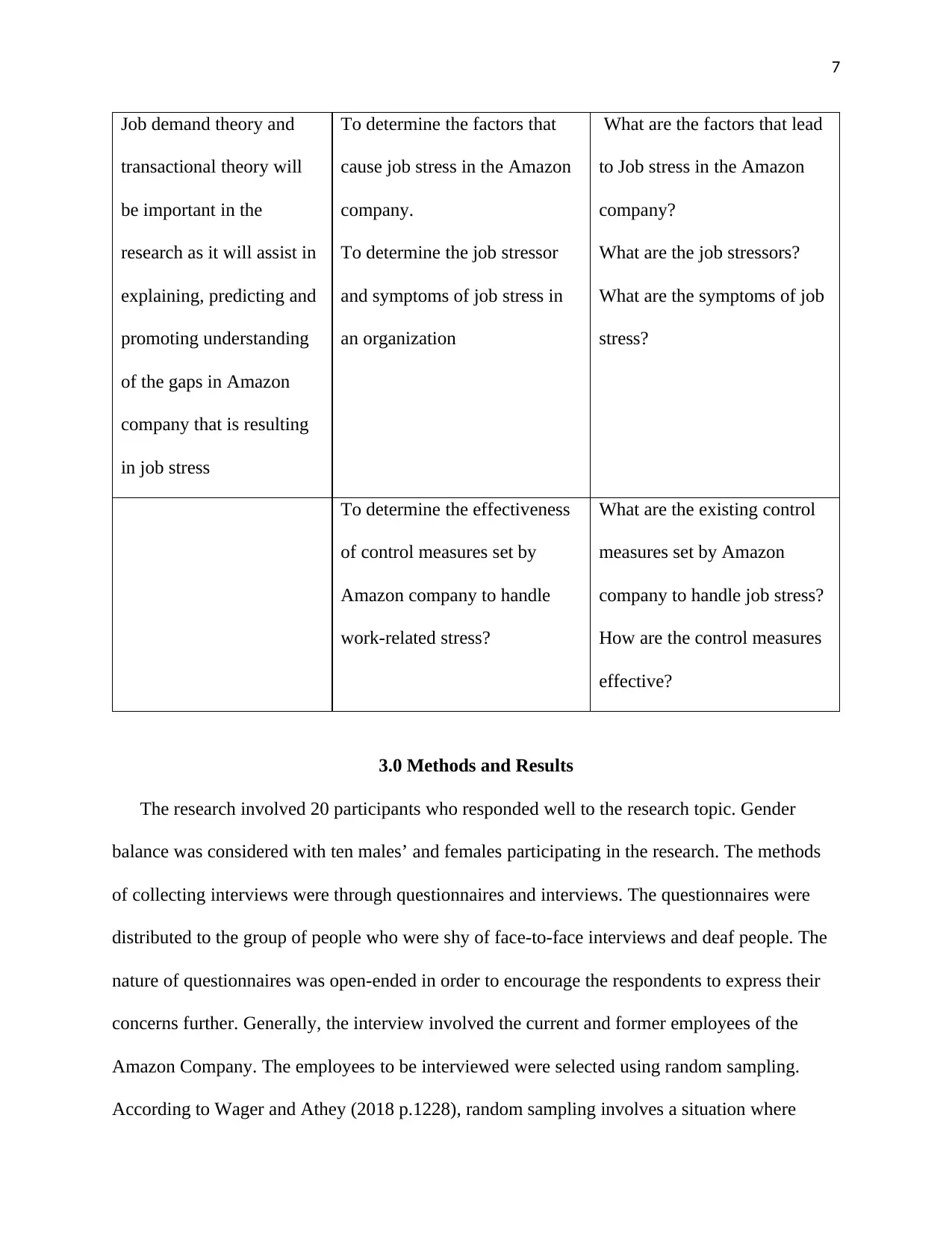
7
Job demand theory and
transactional theory will
be important in the
research as it will assist in
explaining, predicting and
promoting understanding
of the gaps in Amazon
company that is resulting
in job stress
To determine the factors that
cause job stress in the Amazon
company.
To determine the job stressor
and symptoms of job stress in
an organization
What are the factors that lead
to Job stress in the Amazon
company?
What are the job stressors?
What are the symptoms of job
stress?
To determine the effectiveness
of control measures set by
Amazon company to handle
work-related stress?
What are the existing control
measures set by Amazon
company to handle job stress?
How are the control measures
effective?
3.0 Methods and Results
The research involved 20 participants who responded well to the research topic. Gender
balance was considered with ten males’ and females participating in the research. The methods
of collecting interviews were through questionnaires and interviews. The questionnaires were
distributed to the group of people who were shy of face-to-face interviews and deaf people. The
nature of questionnaires was open-ended in order to encourage the respondents to express their
concerns further. Generally, the interview involved the current and former employees of the
Amazon Company. The employees to be interviewed were selected using random sampling.
According to Wager and Athey (2018 p.1228), random sampling involves a situation where
Job demand theory and
transactional theory will
be important in the
research as it will assist in
explaining, predicting and
promoting understanding
of the gaps in Amazon
company that is resulting
in job stress
To determine the factors that
cause job stress in the Amazon
company.
To determine the job stressor
and symptoms of job stress in
an organization
What are the factors that lead
to Job stress in the Amazon
company?
What are the job stressors?
What are the symptoms of job
stress?
To determine the effectiveness
of control measures set by
Amazon company to handle
work-related stress?
What are the existing control
measures set by Amazon
company to handle job stress?
How are the control measures
effective?
3.0 Methods and Results
The research involved 20 participants who responded well to the research topic. Gender
balance was considered with ten males’ and females participating in the research. The methods
of collecting interviews were through questionnaires and interviews. The questionnaires were
distributed to the group of people who were shy of face-to-face interviews and deaf people. The
nature of questionnaires was open-ended in order to encourage the respondents to express their
concerns further. Generally, the interview involved the current and former employees of the
Amazon Company. The employees to be interviewed were selected using random sampling.
According to Wager and Athey (2018 p.1228), random sampling involves a situation where
Paraphrase This Document
Need a fresh take? Get an instant paraphrase of this document with our AI Paraphraser
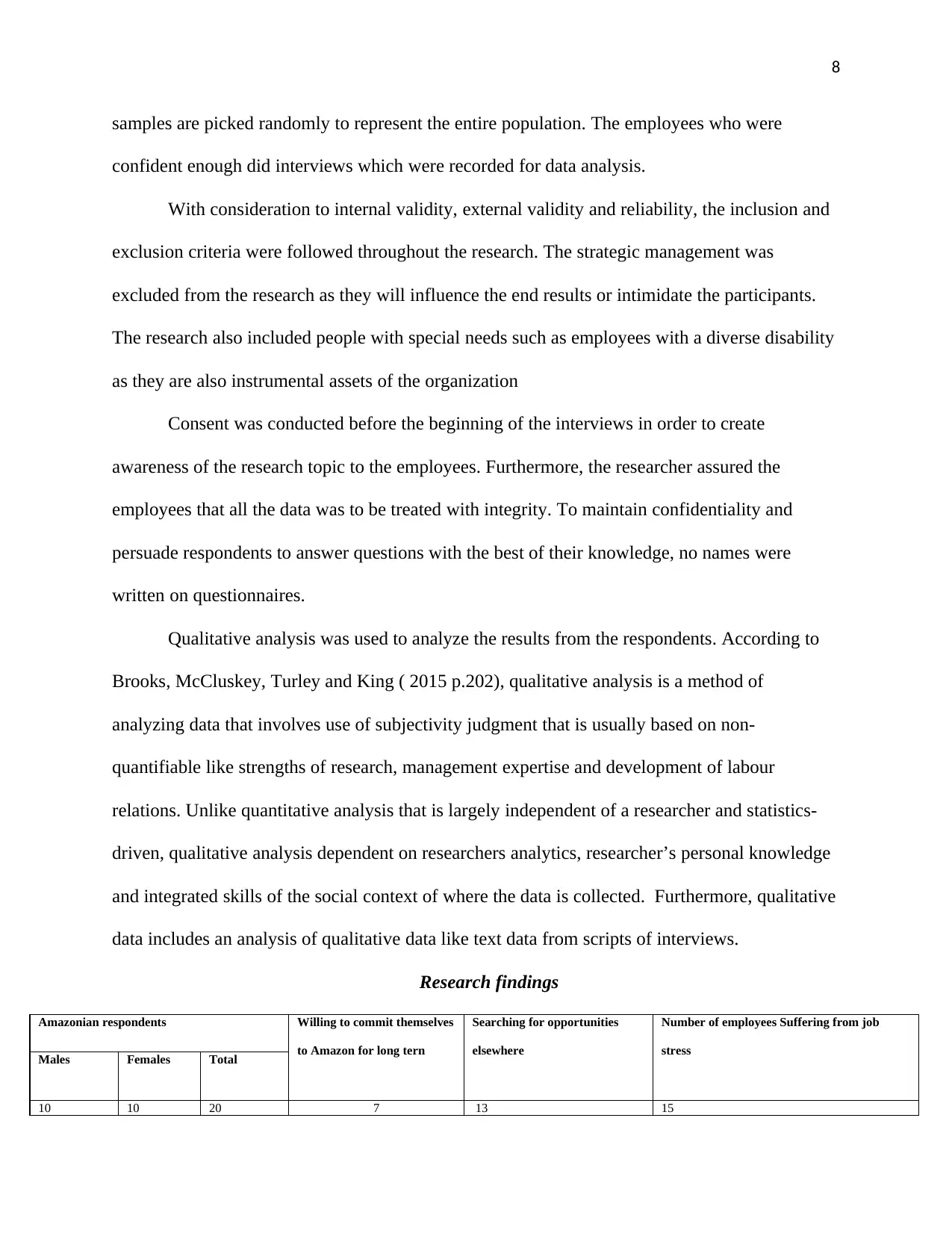
8
samples are picked randomly to represent the entire population. The employees who were
confident enough did interviews which were recorded for data analysis.
With consideration to internal validity, external validity and reliability, the inclusion and
exclusion criteria were followed throughout the research. The strategic management was
excluded from the research as they will influence the end results or intimidate the participants.
The research also included people with special needs such as employees with a diverse disability
as they are also instrumental assets of the organization
Consent was conducted before the beginning of the interviews in order to create
awareness of the research topic to the employees. Furthermore, the researcher assured the
employees that all the data was to be treated with integrity. To maintain confidentiality and
persuade respondents to answer questions with the best of their knowledge, no names were
written on questionnaires.
Qualitative analysis was used to analyze the results from the respondents. According to
Brooks, McCluskey, Turley and King ( 2015 p.202), qualitative analysis is a method of
analyzing data that involves use of subjectivity judgment that is usually based on non-
quantifiable like strengths of research, management expertise and development of labour
relations. Unlike quantitative analysis that is largely independent of a researcher and statistics-
driven, qualitative analysis dependent on researchers analytics, researcher’s personal knowledge
and integrated skills of the social context of where the data is collected. Furthermore, qualitative
data includes an analysis of qualitative data like text data from scripts of interviews.
Research findings
Amazonian respondents Willing to commit themselves
to Amazon for long tern
Searching for opportunities
elsewhere
Number of employees Suffering from job
stress
Males Females Total
10 10 20 7 13 15
samples are picked randomly to represent the entire population. The employees who were
confident enough did interviews which were recorded for data analysis.
With consideration to internal validity, external validity and reliability, the inclusion and
exclusion criteria were followed throughout the research. The strategic management was
excluded from the research as they will influence the end results or intimidate the participants.
The research also included people with special needs such as employees with a diverse disability
as they are also instrumental assets of the organization
Consent was conducted before the beginning of the interviews in order to create
awareness of the research topic to the employees. Furthermore, the researcher assured the
employees that all the data was to be treated with integrity. To maintain confidentiality and
persuade respondents to answer questions with the best of their knowledge, no names were
written on questionnaires.
Qualitative analysis was used to analyze the results from the respondents. According to
Brooks, McCluskey, Turley and King ( 2015 p.202), qualitative analysis is a method of
analyzing data that involves use of subjectivity judgment that is usually based on non-
quantifiable like strengths of research, management expertise and development of labour
relations. Unlike quantitative analysis that is largely independent of a researcher and statistics-
driven, qualitative analysis dependent on researchers analytics, researcher’s personal knowledge
and integrated skills of the social context of where the data is collected. Furthermore, qualitative
data includes an analysis of qualitative data like text data from scripts of interviews.
Research findings
Amazonian respondents Willing to commit themselves
to Amazon for long tern
Searching for opportunities
elsewhere
Number of employees Suffering from job
stress
Males Females Total
10 10 20 7 13 15
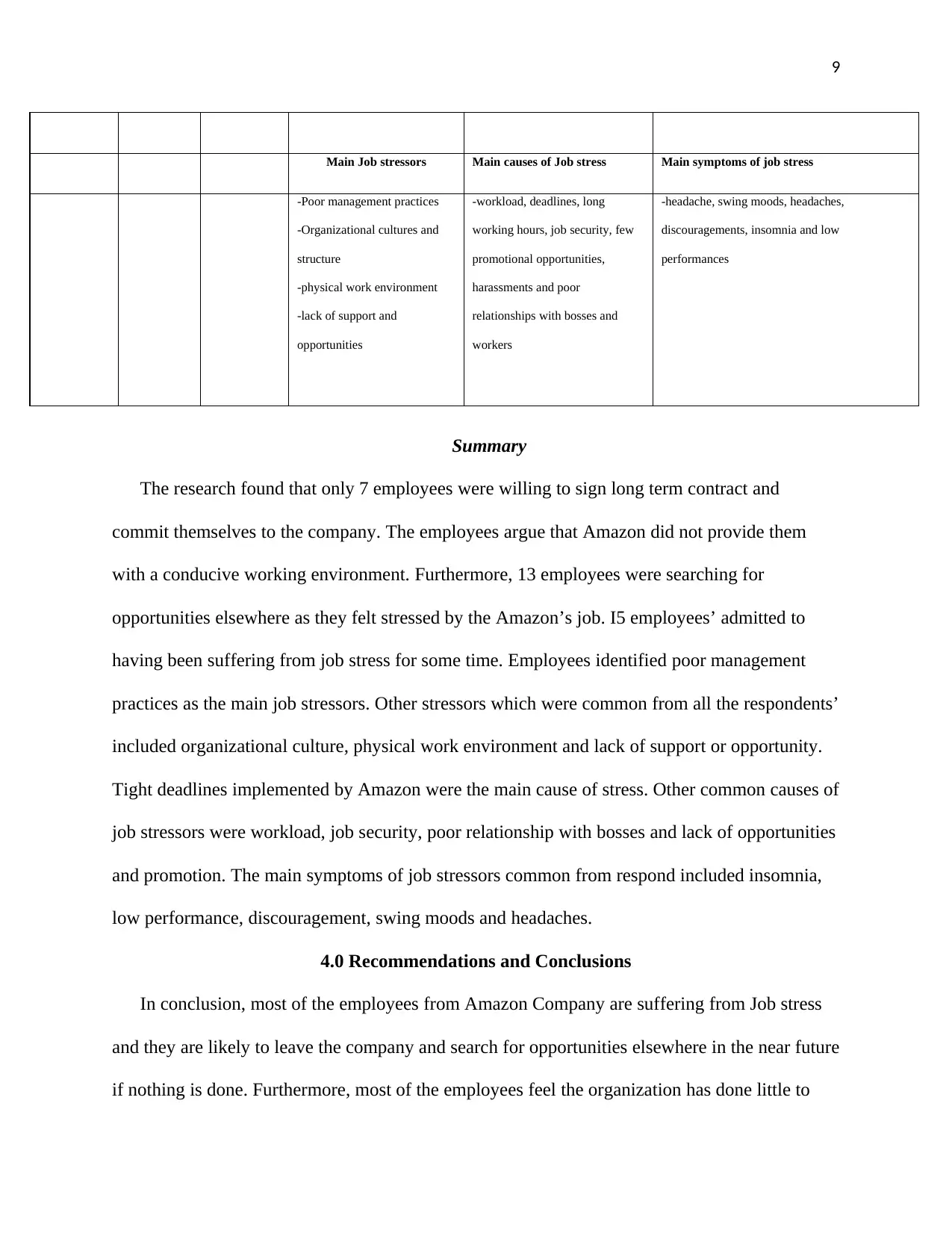
9
Main Job stressors Main causes of Job stress Main symptoms of job stress
-Poor management practices
-Organizational cultures and
structure
-physical work environment
-lack of support and
opportunities
-workload, deadlines, long
working hours, job security, few
promotional opportunities,
harassments and poor
relationships with bosses and
workers
-headache, swing moods, headaches,
discouragements, insomnia and low
performances
Summary
The research found that only 7 employees were willing to sign long term contract and
commit themselves to the company. The employees argue that Amazon did not provide them
with a conducive working environment. Furthermore, 13 employees were searching for
opportunities elsewhere as they felt stressed by the Amazon’s job. I5 employees’ admitted to
having been suffering from job stress for some time. Employees identified poor management
practices as the main job stressors. Other stressors which were common from all the respondents’
included organizational culture, physical work environment and lack of support or opportunity.
Tight deadlines implemented by Amazon were the main cause of stress. Other common causes of
job stressors were workload, job security, poor relationship with bosses and lack of opportunities
and promotion. The main symptoms of job stressors common from respond included insomnia,
low performance, discouragement, swing moods and headaches.
4.0 Recommendations and Conclusions
In conclusion, most of the employees from Amazon Company are suffering from Job stress
and they are likely to leave the company and search for opportunities elsewhere in the near future
if nothing is done. Furthermore, most of the employees feel the organization has done little to
Main Job stressors Main causes of Job stress Main symptoms of job stress
-Poor management practices
-Organizational cultures and
structure
-physical work environment
-lack of support and
opportunities
-workload, deadlines, long
working hours, job security, few
promotional opportunities,
harassments and poor
relationships with bosses and
workers
-headache, swing moods, headaches,
discouragements, insomnia and low
performances
Summary
The research found that only 7 employees were willing to sign long term contract and
commit themselves to the company. The employees argue that Amazon did not provide them
with a conducive working environment. Furthermore, 13 employees were searching for
opportunities elsewhere as they felt stressed by the Amazon’s job. I5 employees’ admitted to
having been suffering from job stress for some time. Employees identified poor management
practices as the main job stressors. Other stressors which were common from all the respondents’
included organizational culture, physical work environment and lack of support or opportunity.
Tight deadlines implemented by Amazon were the main cause of stress. Other common causes of
job stressors were workload, job security, poor relationship with bosses and lack of opportunities
and promotion. The main symptoms of job stressors common from respond included insomnia,
low performance, discouragement, swing moods and headaches.
4.0 Recommendations and Conclusions
In conclusion, most of the employees from Amazon Company are suffering from Job stress
and they are likely to leave the company and search for opportunities elsewhere in the near future
if nothing is done. Furthermore, most of the employees feel the organization has done little to
⊘ This is a preview!⊘
Do you want full access?
Subscribe today to unlock all pages.

Trusted by 1+ million students worldwide
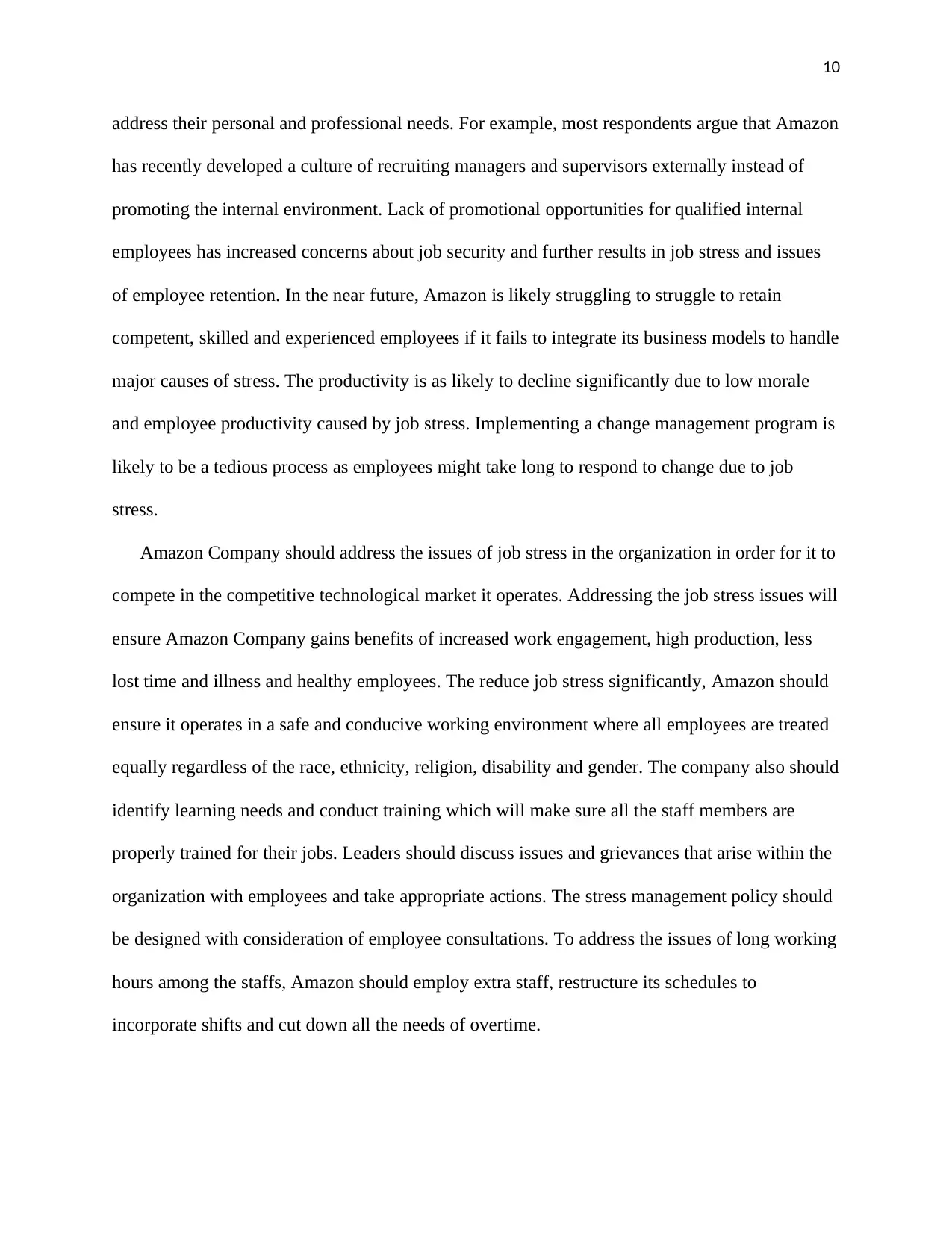
10
address their personal and professional needs. For example, most respondents argue that Amazon
has recently developed a culture of recruiting managers and supervisors externally instead of
promoting the internal environment. Lack of promotional opportunities for qualified internal
employees has increased concerns about job security and further results in job stress and issues
of employee retention. In the near future, Amazon is likely struggling to struggle to retain
competent, skilled and experienced employees if it fails to integrate its business models to handle
major causes of stress. The productivity is as likely to decline significantly due to low morale
and employee productivity caused by job stress. Implementing a change management program is
likely to be a tedious process as employees might take long to respond to change due to job
stress.
Amazon Company should address the issues of job stress in the organization in order for it to
compete in the competitive technological market it operates. Addressing the job stress issues will
ensure Amazon Company gains benefits of increased work engagement, high production, less
lost time and illness and healthy employees. The reduce job stress significantly, Amazon should
ensure it operates in a safe and conducive working environment where all employees are treated
equally regardless of the race, ethnicity, religion, disability and gender. The company also should
identify learning needs and conduct training which will make sure all the staff members are
properly trained for their jobs. Leaders should discuss issues and grievances that arise within the
organization with employees and take appropriate actions. The stress management policy should
be designed with consideration of employee consultations. To address the issues of long working
hours among the staffs, Amazon should employ extra staff, restructure its schedules to
incorporate shifts and cut down all the needs of overtime.
address their personal and professional needs. For example, most respondents argue that Amazon
has recently developed a culture of recruiting managers and supervisors externally instead of
promoting the internal environment. Lack of promotional opportunities for qualified internal
employees has increased concerns about job security and further results in job stress and issues
of employee retention. In the near future, Amazon is likely struggling to struggle to retain
competent, skilled and experienced employees if it fails to integrate its business models to handle
major causes of stress. The productivity is as likely to decline significantly due to low morale
and employee productivity caused by job stress. Implementing a change management program is
likely to be a tedious process as employees might take long to respond to change due to job
stress.
Amazon Company should address the issues of job stress in the organization in order for it to
compete in the competitive technological market it operates. Addressing the job stress issues will
ensure Amazon Company gains benefits of increased work engagement, high production, less
lost time and illness and healthy employees. The reduce job stress significantly, Amazon should
ensure it operates in a safe and conducive working environment where all employees are treated
equally regardless of the race, ethnicity, religion, disability and gender. The company also should
identify learning needs and conduct training which will make sure all the staff members are
properly trained for their jobs. Leaders should discuss issues and grievances that arise within the
organization with employees and take appropriate actions. The stress management policy should
be designed with consideration of employee consultations. To address the issues of long working
hours among the staffs, Amazon should employ extra staff, restructure its schedules to
incorporate shifts and cut down all the needs of overtime.
Paraphrase This Document
Need a fresh take? Get an instant paraphrase of this document with our AI Paraphraser
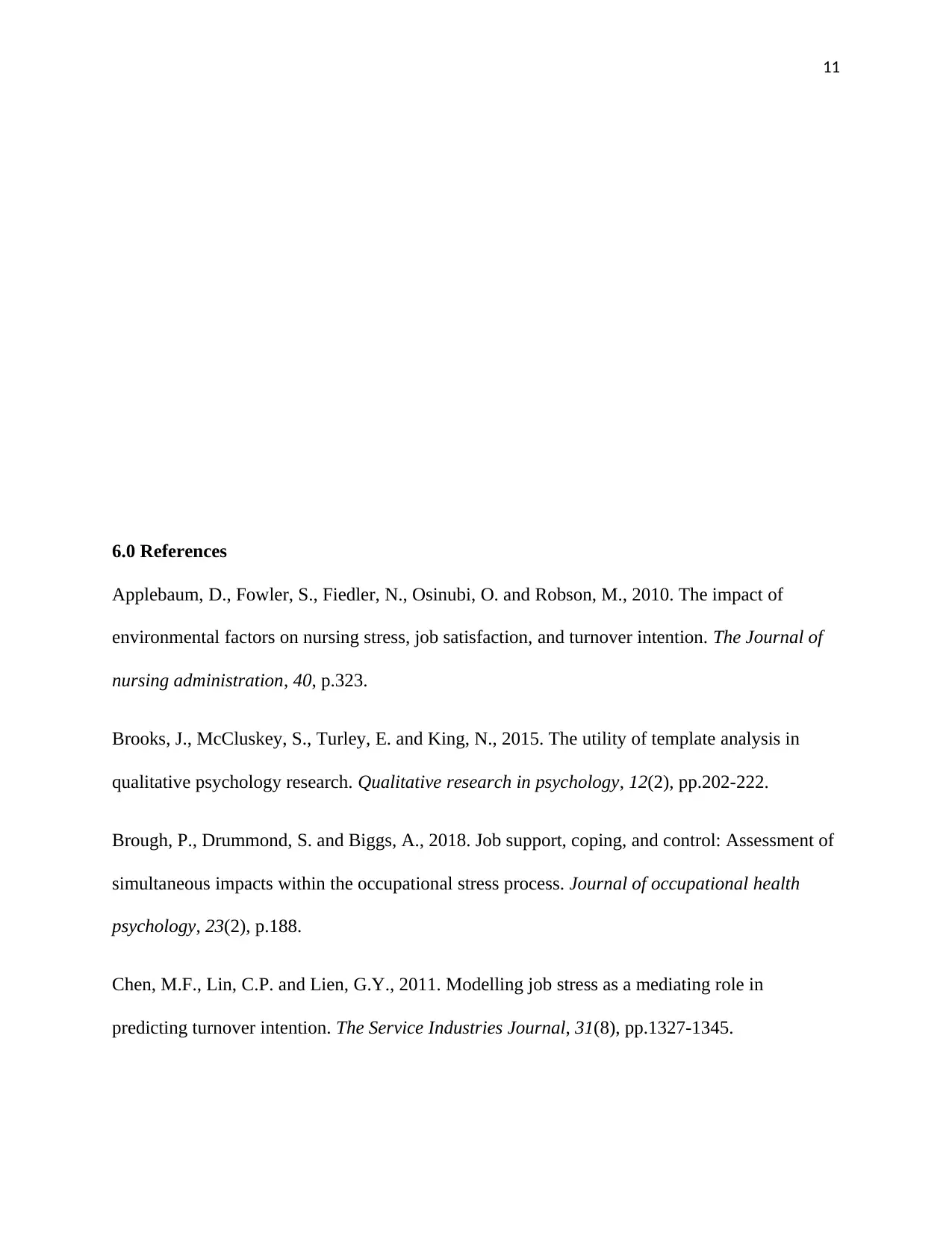
11
6.0 References
Applebaum, D., Fowler, S., Fiedler, N., Osinubi, O. and Robson, M., 2010. The impact of
environmental factors on nursing stress, job satisfaction, and turnover intention. The Journal of
nursing administration, 40, p.323.
Brooks, J., McCluskey, S., Turley, E. and King, N., 2015. The utility of template analysis in
qualitative psychology research. Qualitative research in psychology, 12(2), pp.202-222.
Brough, P., Drummond, S. and Biggs, A., 2018. Job support, coping, and control: Assessment of
simultaneous impacts within the occupational stress process. Journal of occupational health
psychology, 23(2), p.188.
Chen, M.F., Lin, C.P. and Lien, G.Y., 2011. Modelling job stress as a mediating role in
predicting turnover intention. The Service Industries Journal, 31(8), pp.1327-1345.
6.0 References
Applebaum, D., Fowler, S., Fiedler, N., Osinubi, O. and Robson, M., 2010. The impact of
environmental factors on nursing stress, job satisfaction, and turnover intention. The Journal of
nursing administration, 40, p.323.
Brooks, J., McCluskey, S., Turley, E. and King, N., 2015. The utility of template analysis in
qualitative psychology research. Qualitative research in psychology, 12(2), pp.202-222.
Brough, P., Drummond, S. and Biggs, A., 2018. Job support, coping, and control: Assessment of
simultaneous impacts within the occupational stress process. Journal of occupational health
psychology, 23(2), p.188.
Chen, M.F., Lin, C.P. and Lien, G.Y., 2011. Modelling job stress as a mediating role in
predicting turnover intention. The Service Industries Journal, 31(8), pp.1327-1345.
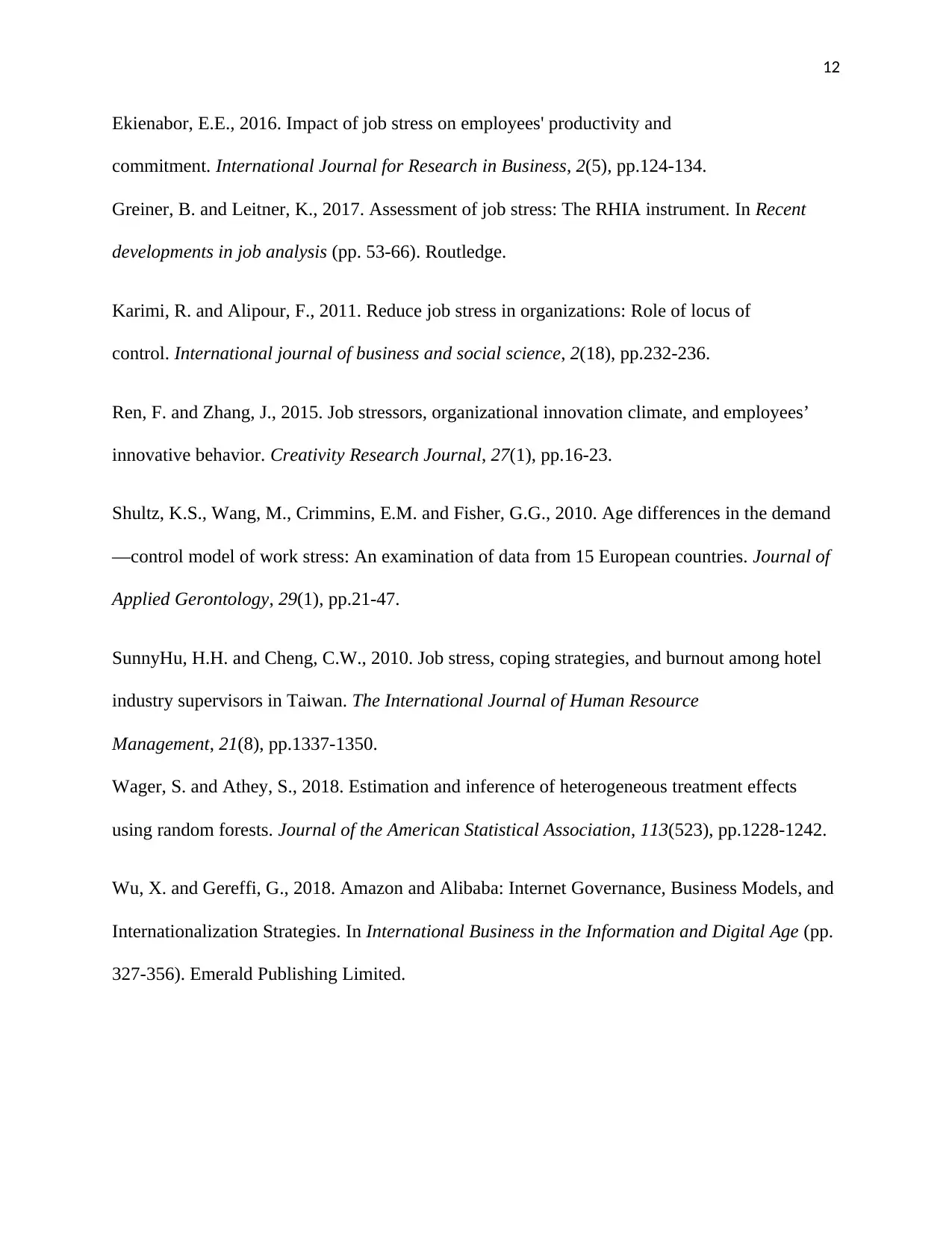
12
Ekienabor, E.E., 2016. Impact of job stress on employees' productivity and
commitment. International Journal for Research in Business, 2(5), pp.124-134.
Greiner, B. and Leitner, K., 2017. Assessment of job stress: The RHIA instrument. In Recent
developments in job analysis (pp. 53-66). Routledge.
Karimi, R. and Alipour, F., 2011. Reduce job stress in organizations: Role of locus of
control. International journal of business and social science, 2(18), pp.232-236.
Ren, F. and Zhang, J., 2015. Job stressors, organizational innovation climate, and employees’
innovative behavior. Creativity Research Journal, 27(1), pp.16-23.
Shultz, K.S., Wang, M., Crimmins, E.M. and Fisher, G.G., 2010. Age differences in the demand
—control model of work stress: An examination of data from 15 European countries. Journal of
Applied Gerontology, 29(1), pp.21-47.
SunnyHu, H.H. and Cheng, C.W., 2010. Job stress, coping strategies, and burnout among hotel
industry supervisors in Taiwan. The International Journal of Human Resource
Management, 21(8), pp.1337-1350.
Wager, S. and Athey, S., 2018. Estimation and inference of heterogeneous treatment effects
using random forests. Journal of the American Statistical Association, 113(523), pp.1228-1242.
Wu, X. and Gereffi, G., 2018. Amazon and Alibaba: Internet Governance, Business Models, and
Internationalization Strategies. In International Business in the Information and Digital Age (pp.
327-356). Emerald Publishing Limited.
Ekienabor, E.E., 2016. Impact of job stress on employees' productivity and
commitment. International Journal for Research in Business, 2(5), pp.124-134.
Greiner, B. and Leitner, K., 2017. Assessment of job stress: The RHIA instrument. In Recent
developments in job analysis (pp. 53-66). Routledge.
Karimi, R. and Alipour, F., 2011. Reduce job stress in organizations: Role of locus of
control. International journal of business and social science, 2(18), pp.232-236.
Ren, F. and Zhang, J., 2015. Job stressors, organizational innovation climate, and employees’
innovative behavior. Creativity Research Journal, 27(1), pp.16-23.
Shultz, K.S., Wang, M., Crimmins, E.M. and Fisher, G.G., 2010. Age differences in the demand
—control model of work stress: An examination of data from 15 European countries. Journal of
Applied Gerontology, 29(1), pp.21-47.
SunnyHu, H.H. and Cheng, C.W., 2010. Job stress, coping strategies, and burnout among hotel
industry supervisors in Taiwan. The International Journal of Human Resource
Management, 21(8), pp.1337-1350.
Wager, S. and Athey, S., 2018. Estimation and inference of heterogeneous treatment effects
using random forests. Journal of the American Statistical Association, 113(523), pp.1228-1242.
Wu, X. and Gereffi, G., 2018. Amazon and Alibaba: Internet Governance, Business Models, and
Internationalization Strategies. In International Business in the Information and Digital Age (pp.
327-356). Emerald Publishing Limited.
⊘ This is a preview!⊘
Do you want full access?
Subscribe today to unlock all pages.

Trusted by 1+ million students worldwide
1 out of 12
Related Documents
Your All-in-One AI-Powered Toolkit for Academic Success.
+13062052269
info@desklib.com
Available 24*7 on WhatsApp / Email
![[object Object]](/_next/static/media/star-bottom.7253800d.svg)
Unlock your academic potential
Copyright © 2020–2025 A2Z Services. All Rights Reserved. Developed and managed by ZUCOL.





